ANTHROPOMETRICAL RESEARCH OF DIAGNISTIC MODELS OF JAWS WITH THE USE OF CRITERIA OF THE END OF ORTHODONTIC TREATMENT (THE AMERICAN BOARD OF ORTHODONTICS (ABO))
Дудник О.В.1, Мамедов А.А.2, Дыбов А.М.3, Харке В. В.4, Холмогорова П. В.5
1Ассистент, 2Доктор медицинских наук, профессор, 3Кандидат медицинских наук, доцент, 4Кандидат медицинских наук, доцент, 5студентка 4 курса, Федеральное государственное бюджетное образовательное учреждение высшего образования Первый Московский государственный медицинский университет имени И.М. Сеченова Министерства здравоохранения Российской Федерации
АНТРОПОМЕТРИЧЕСКОЕ ИССЛЕДОВАНИЕ ДИАГНОСТИЧЕСКИХ МОДЕЛЕЙ ЧЕЛЮСТЕЙ С ПРИМЕНЕНИЕМ КРИТЕРИЕВ ОКОНЧАНИЯ ОРТОДОНТИЧЕСКОГО ЛЕЧЕНИЯ (THE AMERICAN BOARD OF ORTHODONTICS (ABO))
Аннотация
Целью данного исследования было повышение эффективности ортодонтического лечения, путём применения на завершающем этапе антропометрической системы количественной оценки диагностических моделей. Было обследовано 32 пациента. Всем пациентам проводилось ортодонтическое лечение с использованием брекет-системы активного самолигирования техники прямой дуги, с применением на этапе юстировки антропометрической системы количественной оценки (The ABO Model Grading System). Оценки эффективности ортодонтического лечения по системе АБО на завершающих стадиях во второй группе были значительно ниже, чем в первой (p = 0,002248; p=0,023431, соответственно).
Ключевые слова: ортодонтическое лечение, диагностика, антропометрическое исследование, юстирование, центральная окклюзия, центральное положение.
Dudnik O.V.1, Mamedov A.A.2, Dybov A.M.3, Kharke V.V.4, Kholmogorova P.V.5
1Assistant, 2MD, Professor, 3MD, Associate Professor, 4MD, Associate Professor, 5student of 4 course, State Federal-Funded Educational Institution of Higher Professional Training I.M. Sechenov First Moscow State Medical University of the Ministry of Health of the Russian Federation
ANTHROPOMETRICAL RESEARCH OF DIAGNISTIC MODELS OF JAWS WITH THE USE OF CRITERIA OF THE END OF ORTHODONTIC TREATMENT (THE AMERICAN BOARD OF ORTHODONTICS (ABO))
Abstract
The purpose of this investigation was to improve the efficiency of the final stage of orthodontic treatment. The study included 32 patients. All patients of orthodontic treatment was performed using a bracket system active self-ligation straight arc technique with step adjustment anthropometric quantitative evaluation system (The ABO Model Grading System). Estimates of the efficiency of orthodontic treatment on the ABO system in the late stages of adjustment the second group was significantly lower than in the first (p = 0,002248; p=0,023431, respectively).
Keywords: orthodontic treatment, diagnosis, anthropometric studies, adjustment, central occlusion, centric relation.
Introduction
The structural features of the dentition and bones a facial skull [2, P.114], [3,120] diagnostics and treatment of pathologies the dentofacial of anomalies are studied rather in detail, however a question of criteria of the end of orthodontic treatment remains poorly studied.
In 1972 Lawrence Andrews offered six keys of a normal occlusion which became one of postulates by which many orthodontists at the final stage of orthodontic treatment are guided [4, P.120].
Desire of the American society of orthodontists (American Board of Orthodontics became a starting point of studying of an optimum occlusion — ABO) to frame system of criteria for evaluation of complete results of treatment, by assessment of plaster models and orthopantomograms [1, P. 589]. At the moment this system has rather widespread use for the western colleagues [5, P.112], [6, P. 468], [7, P.32], [8, P.589] , [9, P. 381] and is a little coverage in our country .
The analysis the Russian literature shows that else it is necessary to solve a series of the tactical tasks devoted to this question.
Purpose
Improving the efficiency of orthodontic treatment, by use at the final stage of anthropometric system of quantitative assessment of diagnostic models.
Materials and methods
When performing a research 58 patients aged from 14 up to 35 years old with the diagnosis - dense position of teeth in the top and a mandible without disturbance of provision of gnathic bones were examined, of which 32 patients were included in medical group.
At selection in group the following criteria were used:
- Age of patients of 14-35 years, period of a constant occlusion.
- Patients at the orthodontist weren't treated earlier.
- Dentoalveolar form an orthognathic occlusion.
- Symmetric growth maxilla and mandible.
- Dense position of teeth on maxilla and a mandible does not exceed 4 mm.
- Lack of the impacted teeth according to an orthopantomography, except for the third molar tooths maxilla and a mandible.
- Sanitated oral cavity. Safe anatomy of crowns of teeth.
Patients of medical group were divided into two groups of 16 people in everyone. In this case –in each group there was a peer number of men and women. To all patients orthodontic treatment with use of breket-system of an active self-ligation of the equipment of a direct arch, with use at a stage of an adjustment of anthropometric system of quantitative assessment (The ABO Model Grading System) developed by the American Society of Orthodontists (The American Board of Orthodontics) in 1999 was carried out.
Measurements were performed on the following indicators:
1. alignment of crowns of frontal teeth in the vestibulo-oral direction (fig. 1. a, b).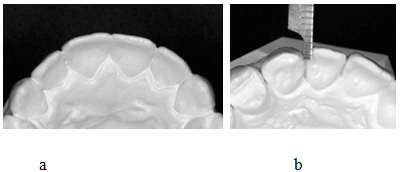
Fig. 1 - Alignment of crowns of frontal teeth in the vestibulo-oral direction (a), an aberration (b)
2. alignment of crowns of side teeth in the vestibulo-oral direction (fig. 2. a, b).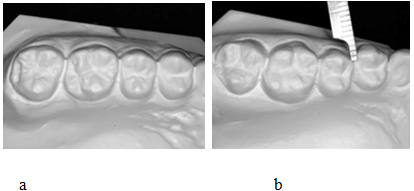
Fig. 2 - Alignment of crowns of side teeth in the vestibulo-oral direction (a), an aberration (b)
3. alignment of regional crests of side teeth in the vertical direction (fig. 3. a, b).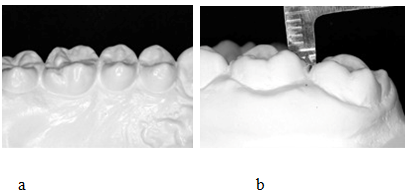
Fig. 3 - Alignment of regional crests of side teeth in the vertical direction (a), an aberration (b)
4. correct buсcolingual inclination of side teeth (fig. 4. a, b).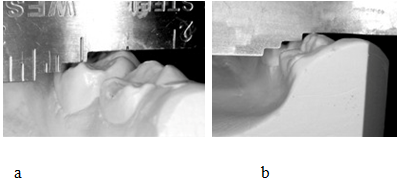
Fig. 4 - A correct buсcolingual inclination of side teeth on the lower jaw (a), an aberration (b)
5. occlusal contacts in side departments (fig. 5 a, b).
Fig. 5 - A correct occlusal contacts in side departments
6. occlusal relationship in side departments (fig. 6 a, b).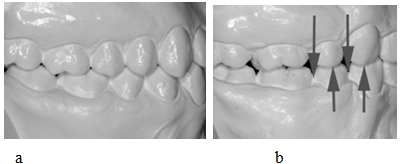
Fig. 6 - A correct occlusal relationship in side departments (a), an aberration (b)
7. interproximal contacts (fig. 7 a, b).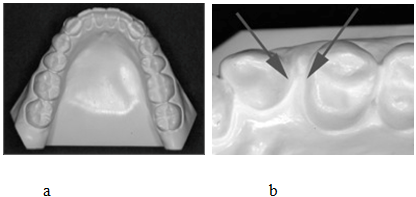
Fig. 7 - Correct interproximal contacts (a), an aberrations (b)
Besides, from archive of department of stomatology of children's age and orthodontics of the First MSMU of I. M. Sechenov 96 plaster models of the jaws made on the end of orthodontic treatment were studied.
According to the medical documentation in case of selection in group the following criteria were used:
- Age of patients of 14-35 years, period of a fixed bite.
- Dentoalveolar form of ortognatichesky occlusion.
- Symmetric growth of the upper and lower jaw.
- The dense provision of teeth on the upper and lower jaw doesn’t exceed 4 mm.
- Lack of the impacted teeth according to an orthopan-tomography except for the third painters of the upper and lower jaw.
Upon completion of the research 35 plaster models of jaws for anthropometrical studying using anthropometrical system of quantitative assessment of ABO were selected.
The Variation and the statistical handling are carried out by the methods, commonly accepted for medicobiological researches: calculation of arithmetic averages of sizes, an average square deviation, representativeness error for each parametes, comparison of the average sizes by criterion of U-Mann-Whitney and T-Wilcoxon with reliability of distinctions in case of (p <0,05) by means of a software package of EXEL 14.1.0 (Microsoft).
Results and their discussions
According to statistical handling, the researching groups at the beginning of the final stage of the treatment were uniformed in expressiveness of criteria of the ABO system.
When carrying out an anthropometrical research on the ABO system in 1 and 2 groups the following indicators of a percent age ratio of mistakes were revealed:
- violation a provision of crowns of teeth in the vestibulo-oral direction (rotation) (93,75%)
- violation of a ratio of regional crests of side teeth in the vertical direction (56,25%)
- buccolingual inclination of side teeth (75%)
- violation the oclusal of contacts in side departments (81,25%)
As showed on this research, the most amount of mistakes is are allowed in case of equalization of a provision of side group of teeth on the upper and lower jaw:
- equalization of longitudinal fissures of the first painters on the upper jaw (96%),
- equalization of longitudinal fissures of the second painters on the upper jaw (82%),
- equalization of longitudinal fissures of the first painters on the lower jaw (63%),
- equalization of longitudinal fissures of the second painters on the lower jaw (68%).
Also, when carry out the comparison of the received results for two researching groups with group of archive it was succeeded to reveal the following: the quantitative indices of criteria on the ABO system measured at patients of groups 1 and 2 at the initial stage of treatment were significantly more indicators received on diagnostic models of archive (tab. 1, 2).
Table 1 - Comparison of quantification of criteria of orthodontic treatment (ABO system) in group 1 and contemporary records at the beginning of the final stage of treatment
| Criteria of ABO | Group 1 | Archives | U-Mann Whitney | p-lever | ||
| M | s | M | s | |||
| Aligment of crowns of frontal teeth in the vestibulo - oral direction | 2,375 | 0,619139 | 0,542857 | 0,560612 | 5,5 | <0,001 |
| Aligment of crowns of lateral teeth in the vestibulo-oral direction | 3,34375 | 0,768521 | 1,557143 | 1,012941 | 41,5 | <0,001 |
| Equalization of marginal of crests of lateral teeth in the verical direction | 1,65625 | 0,72385 | 0,428571 | 0,608069 | 60,5 | 0,000001 |
| Correct bucco-lingual inclination of lateral teeth | 2,125 | 0,903696 | 0,514286 | 0,612201 | 42 | <0,001 |
| Occlusal contacts in side departments | 2,03125 | 0,991106 | 0,428571 | 0,708591 | 52,5 | <0,01 |
| Occlusal ratios in side departments | 2,25 | 1,032796 | 0,642857 | 1,687198 | 70 | 0,000005 |
| Interdental contacts | 1,03125 | 1,175709 | 0,142857 | 0,355036 | 150 | 0,007590 |
Table 2 - Comparison of quantification of criteria of orthodontic treatment (ABO system) in group 2 and contemporary records at the beginning of the final stage of treatment
| Criteria of ABO | Group 2 | Archives | U-Mann Whitney | p-lever | ||
| M | s | M | s | |||
| Aligment of crowns of frontal teeth in the vestibulo – oral direction | 2,40625 | 0,52341 | 0,542857 | 0,560612 | 4 | <0,001 |
| Aligment of crowns of lateral teeth in the vestibulo-oral direction | 3,375 | 0,806226 | 1,557143 | 1,012941 | 41,5 | <0,001 |
| Aligment of marginal crests of lateral teeth in the vestibulo-oral direction | 1,65625 | 0,72385 | 0,428571 | 0,608069 | 60,5 | 0,000001 |
| Correct bucco-lingual inclination of lateral teeth | 2,125 | 0,76385 | 0,514286 | 0,612201 | 35 | <0,001 |
| Occlusal contacts in side departments | 2 | 0,774597 | 0,428571 | 0,708591 | 46 | <0,001 |
| Occlusal ratios in side departments | 2,25 | 0,816497 | 0,642857 | 1,687198 | 70,5 | 0,000005 |
| Interdental contacts | 1,03125 | 0,921389 | 0,142857 | 0,355036 | 127,5 | 0,00147 |
The efficiency evaluation of orthodontic treatment on the ABO system which at the end of a stage of an adjustment shown that in both groups statistically significant decrease in quantitative indices of mistakes at the final stage of treatment (tab. 3, 4).
Table 3 - Quantification of criteria of orthodontic treatment (ABO system) in group 1 at the final stage of treatment
| Criteria of ABO | Beginning of a stage of an ajustment | Finish of a stage of an ajustment | T- Wilcoxon | p- lever | ||
| M | s | M | s | |||
| Equalization of crowns of frontal teeth in the vestibulo-oral direction | 2,375 | 0,619139 | 0,5 | 0,516398 | <0,00001 | 0,000438 |
| Equalization of crowns of lateral teeth in the vestibulo-oral direction | 3,34375 | 0,768521 | 1,34375 | 0,831039 | <0,00001 | 0,000438 |
| Equalization of marginal crests of lateral teeth in the vertical direction | 1,65625 | 0,72385 | 0,5 | 0,7302 | <0,00001 | 0,000655 |
| Correct bucco-lingual inclination of lateral teeth | 2,125 | 0,903696 | 0,5625 | 0,629153 | <0,00001 | 0,000438 |
| Occlusal contacts in side departments | 2,03125 | 0,991106 | 0,625 | 0,82664 | <0,00001 | 0,000438 |
| Occlusal ratios in side departments | 2,25 | 1,032796 | 0,5625 | 0,981071 | <0,00001 | 0,000438 |
| Interdental contacts | 1,03125 | 1,175709 | 0,25 | 0,447214 | 0,00001 | 0,007686 |
Table 4 - Quantification of criteria of orthodontic treatment (ABO system) in group 2 at the final stage of treatment
| Criteria of ABO | Beginning of a stage of an ajustment | Finish of a stage of an ajustment | T-Wilcoxon | p-lever | ||
| M | s | M | s | |||
| Equalization of crowns of frontal teeth in the vestibulo-oral direction | 2,40625 | 0,52341 | 0,1875 | 0,359398 | <0,00001 | 0,000438 |
| Equalization of crowns of lateral teeth in the vestibulo-oral direction | 3,375 | 0,806226 | 0,4375 | 0,512348 | <0,00001 | 0,000438 |
| Equalization of marginal crests of lateral teeth in the vertical direction | 1,65635 | 0,72385 | 0,34375 | 0,507239 | <0,00001 | 0,000655 |
| Correct bucco-lingual inclination of lateral teeth | 2,125 | 0,763763 | 0,03125 | 0,125000 | <0,00001 | 0,000438 |
| Occlusal contacts in side departments | 2 | 0,774597 | 0,3125 | 0,478714 | <0,00001 | 0,001474 |
| Occlusal ratios in side departments | 2,25 | 0,816497 | 0,03125 | 0,125000 | <0,00001 | 0,000438 |
| Interdental contacts | 1,03125 | 0,921389 | 0,000000 | 0,000000 | <0,00001 | 0,5062 |
However, it should be noted, at the end of the final stage of treatment an error of equalization of crowns of side teeth in the vestibulo-oral direction and a correctness of a buccolingual inclination of side teeth in group 2 were significantly lower in comparison with group 1 (p=0,002248; p=0,023431, respectively). Thus, in the 2nd group in the course of treatment of an error of equalization of crowns of side teeth in the vestibulo-oral direction and a correctness of a buccolingual inclination of side teeth decreased significantly more intensively in comparison with group 1 (fig. 8, 9) that can be regarded as an indicator of bigger efficiency of treatment in the 2nd group.
Also, when carry out the comparison of the received results of two studied groups with group of archive it was succeeded to reveal the followed, quantitative indices of criteria on the ABO system measured at patients of groups 1 and 2 at the initial stage of treatment there were significantly more indicators received on diagnostic models. However, at the end of the final stage of treatment the most of the part of indicators in both groups significantly didn't differ from data of group of archive. Distinctions were observed only in an error of alignment of crowns of side teeth in the vestibulo-oral direction and a correct buccolingual inclination of side teeth which in group 2 were significantly below similar indicators of group of archive (fig. 10).
Conclusion
Thus, the application of the final stage anthropometric system quantify ABO followed over fixing incorrectly positioned brackets by indirect bonding, will provide decreasing the chance of emergence occlusion interference and will achieve accurate results of orthodontic treatment.
Список литературы / References
- Хватова В.А. Функциональная диагностика и лечение в стоматологии / В.А. Хватова. – М.: Медицинская книга, 2007. - 294 с.
- Хорошилкина Ф.Я. Ортодонтия. Профилактика и лечение функциональных, морфологических и эстетических нарушений в зубочелюстно-лицевой области / Ф.Я. Хорошилкина, Л. С. Персин, В.П. Окушко-Калашникова. - Москва, 2005. – 460 с.
- Andrews L.F. Straight wire: the concepts and appliance / L.F. Andrews. - LA Wells, 1989. – 120 p.
- Casko J.S. American Board of Orthodontics Objective grading system for dental casts and panoramic radiographs / J.S. Casko, J.L. Vaden, V.G. Kokich and others // Am J Orthod Dentofacial Orthop. -1998. - P. 589-599.
- Okeson J. The management of temporamandibular disordersand occlusion / J. Okeson. - Mosby, 2007. - 565 p.
- Pulfer R.M., Drake C.T., Maupome G. The association of malocclusion complexity and orthodontic treatment outcomes / R.M. Pulfer, C.T. Drake, G. Maupome // Angle Orthod. - 2009. – P. 468-472.
- Roth R.H. Functional occlusion for the orthodontist / R.H. Roth // part I. J. Clin. Orthod. -1981. - Vol. 15. - P. 32-51.
- Zhang M., McGrath C., Hagg U. The impact of malocclusion and its treatment on quality of life: a literature review / M. Zhang, C. McGrath, U. Hagg // Int J paediatr Dent. - 2006. – Vol. 16 (6). - P. 381-387.
Список литературы на английском языке / References in English
- Hvatova V.A. Funkcional'naya diagnostika i lechenie v stomatologii [Functional diagnostics and treatment in dentistry] / V.A. Hvatova. – M.: Medicinskaya kniga [Medical book], 2007. - 294 p. [in Russian]
- Horoshilkina F.YA. Ortodontiya. Profilaktika i lechenie funkcional'nyh, morfologicheskih i ehsteticheskih narushenij v zubochelyustno-licevoj oblasti [Orthodontia. Prophylaxis and treatment of functional morphological and esthetic disturbances in dentoalveolar and facial area] / F.YA. Horoshilkina, L. S. Persin, V.P. Okushko-Kalashnikova. - Moskva [Moscow], 2005. – 460 p. [in Russian]
- Andrews L.F. Straight wire: the concepts and appliance / L.F. Andrews. - LA Wells, 1989. – 120 p.
- Casko J.S. American Board of Orthodontics Objective grading system for dental casts and panoramic radiographs / J.S. Casko, J.L. Vaden, V.G. Kokich and others // Am J Orthod Dentofacial Orthop. -1998. - P. 589-599.
- Okeson J. The management of temporamandibular disordersand occlusion / J. Okeson. - Mosby, 2007. - 565 p.
- Pulfer R.M., Drake C.T., Maupome G. The association of malocclusion complexity and orthodontic treatment outcomes / R.M. Pulfer, C.T. Drake, G. Maupome // Angle Orthod. - 2009. – P. 468-472.
- Roth R.H. Functional occlusion for the orthodontist / R.H. Roth // part I. J. Clin. Orthod. -1981. - Vol. 15. - P. 32-51.
- Zhang M., McGrath C., Hagg U. The impact of malocclusion and its treatment on quality of life: a literature review / M. Zhang, C. McGrath, U. Hagg // Int J paediatr Dent. - 2006. – Vol. 16 (6). - P. 381-387.
